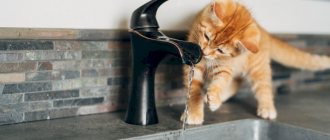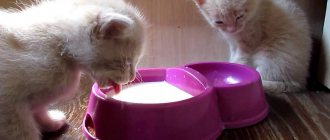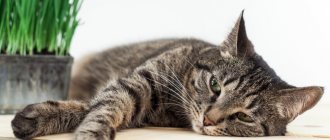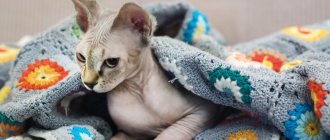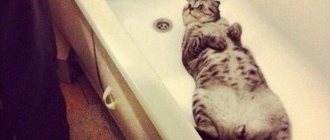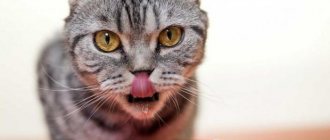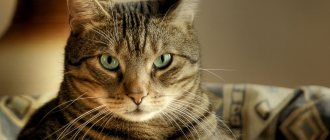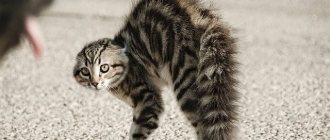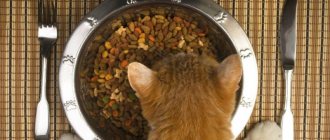Legends can be made about the pickiness of cats and their quirks regarding food. The wrong temperature, the wrong shape of the pieces, the wrong angle of the head, retrograde Mercury - what reasons do furry gourmets find to show their dissatisfaction with the diet! Sometimes these are just whims, but sometimes the problem really lies in the bowl. Incorrectly selected dishes can be a serious nuisance for your cat. Let's look at what factors should be taken into account when choosing a bowl for food and water.
What could be wrong with the bowl?
Smell
Cats are very sensitive to unpleasant odors: they pick up even those that are inaccessible to our sense of smell. So a bowl made of cheap plastic can become a real problem - the animal simply will not approach it. If the relationship with the new dishes does not work out, it is quite possible that the reason is the smell.
You can find out whether a bowl has a specific “aroma” with a simple experiment. Pour hot water into it and sniff it: as a rule, when heated, the smell becomes much brighter.
There is another situation: a well-known bowl has absorbed the smell of spoiled food and has become objectionable to your pet. Or you washed it with a strong-smelling chemical: this can also scare the cat away.
Sometimes the source of the unpleasant odor may not be related to the bowl or food at all. For example, nearby there is a cat litter box or containers with household chemicals, scented candles or an automatic diffuser that sprays aroma for the home. It is best to place the cat's bowl in a neutral-smelling area, away from strong-smelling substances.
Shape and size
Here, too, we are not talking about pickiness, but about the characteristics of the animal. The fact is that a cat's whiskers are a very important and particularly sensitive organ that is responsible for the sense of touch. If an animal constantly touches the side of the bowl with its whiskers while eating, this can cause serious discomfort and even cause refusal to eat. Therefore, it is best to choose bowls that are wide enough with small sides so that the cat does not have to catch the food with its paw and put it on the floor. However, food that is too flat will cause food to fall out. It is optimal to choose a plate with a depth of 3–4 cm.
Material
Sometimes the reason for refusing a bowl can be the characteristics of the material. Perhaps it is too light and moves while eating, or dry food makes an unpleasant sound when it comes into contact with the sides. We looked at the main pros and cons of bowls made from different materials. See if you can find the reason why your cat is not eating from the bowl.
The importance of quality cookware
It would seem that there is nothing difficult in choosing a bowl for a cat. A caring owner buys a container of some intricate shape that he likes, and even a double or triple one, pours delicious food into it, and... watches as his pet takes out pieces and eats them on the floor. This happens when the cat's bowl doesn't fit because it's uncomfortable.
You need to choose a bowl for food based on the characteristics of the breed, character and personal preferences of the animal:
- many cats like to eat on half-bent legs, as if reclining, so a container with high sides is inconvenient for them;
- almost all pets are unhappy when the bowl is narrow and the whiskers touch its edges;
- the height of the sides should correspond to the type of food: for canned food and natural food it is better to choose a low container in the form of a “bowl”; for dry food, a bowl with high sides is preferable;
- water should be poured into a wide container with sides of medium height - cats associate low plates with puddles and can cause disgust;
- the shape and depth of the bowl depends on the breed of cat: pets with flat faces (exotics, Persians) find it uncomfortable to eat from narrow and deep plates;
- at the same time, cats with long hair need bowls with fairly high sides, since when using a shallow plate, the animal’s hair will constantly get dirty.
An integral attribute of the tableware is the stand. This is not to say that you cannot do without it, because cats are more flexible creatures than dogs and they do not have problems such as curvature of the spine due to low dishes. However, a stand under cat food bowls makes eating much easier, since your pet does not have to bend down. The most convenient are stable wooden stands with cut-in niches for bowls or tray-shaped structures.
If the bowl is used without a stand, then it is advisable to place a rubberized mat under it to prevent the dishes from sliding on the floor. You can also purchase original containers with suction cups on the bottom, which firmly fix the bowl.
Pros and cons of cat bowls made of different materials
Plastic bowls
Pros:
They are inexpensive and can be found in any store. Large selection of shapes and shades.
Minuses:
unhygienic, grease is difficult to wash off from plastic, and bacterial deposits form. They quickly deteriorate, get scratched, and lose their original appearance. Too light, the cat may move the bowl while eating. May be toxic, have an unpleasant odor, and cause allergies.
Metal bowls
Pros:
not much more expensive than plastic. Durable, hygienic, easy to clean.
Minuses:
noisy, dry food “rattles” while eating. Lightweight, they can slide on the floor if they do not have a rubber sticker on the bottom, and irritate the cat and others. Not suitable for microwaves: if you decide to reheat food, you need to use a different container. A modest assortment, usually round bowls in metallic color.
Ceramic and porcelain bowls
Pros:
safe for health, environmentally friendly, hygienic. They are easy to clean and do not absorb odors. Heavy in a good way, they won't slide on the floor while eating. Durable, they need to be changed less often than plastic and metal ones. Can be used in the microwave. Large selection of sizes, shades and shapes.
Minuses:
more expensive than plastic and metal ones. May break if used carelessly. Heated in the microwave.
Neighborhood of food and water
Some cats don't mind at all if food and water are placed side by side in a double bowl. But sometimes such proximity can become a problem. For example, if pieces of food fall into the water and spoil it. Or the smell of stagnant water repels the cat from the food bowl.
Still, the best option would be to purchase a separate bowl for water and place it a little away from the food. It should also not be too deep and odorless. The optimal capacity is about 250 ml. This will be enough for a day, and the cat will not be left without water. Some fluffies prefer to drink from large containers, considering water in small containers not pure enough. Observe your pet to understand its preferences.
The cleanliness of the water container must be regularly monitored so that the walls are not covered with mucus and the water does not stagnate. You will immediately understand that something is wrong with the bowl if the cat starts drinking from other places - the sink, bathtub or even toilet.
Ceramic bowls for cats
Most nurseries recommend using ceramic bowls for regular use. They are heavy, so a cat will hardly be able to play football with them, they retain heat and cold perfectly, are easy to clean, and retain an attractive appearance for a long time. Modern manufacturers offer a wide range of colors and shapes, and some can even “print” your pet’s name on the bowl.
Disadvantages: high cost and relative fragility. While a plastic or metal bowl doesn’t mind falling from a height, a ceramic bowl will most likely break.
How to avoid problems with bowls
- Buy dishes for animals in trusted stores and do not use containers not intended for food.
- Place the cat's bowl in a well-accessible, ventilated place without foreign odors.
- Use a matte, non-slip mat or cat litter to keep the floor clean. It will also help keep the bowl from slipping away from your cat while he eats.
- Make sure your food bowl is filled regularly and change the water promptly.
- Wash your cat's dishes thoroughly before each use, and choose unscented products.
- Do not mix different types of food in one bowl - dry and wet, specialized food and homemade food. If you need to give your cat a varied diet throughout the day, it is better to use double bowls.
Metal bowls for cats
Stainless steel bowls are a good option for every day. They do not accumulate static voltage, do not promote the growth of bacteria, are hypoallergenic, and easy to use. The downside is the same noise: some particularly playful representatives of the cat family knock their bowl on the floor, producing an unimaginable amount of noise. A rubberized bottom solves this problem.
In addition, stainless steel bowls are not particularly beautiful. Of course, you can buy a metal feeder with an enamel surface, but over time the enamel cracks and microbes can grow in it, which, again, can lead to allergies or acne in your pet.
Or maybe the problem is not in the bowl?
Quite possible. If a cat systematically ignores food, it’s worth taking a closer look and finding out the reason. Among the most common: inappropriate or windy food, change of teeth (important for older kittens), heat (both in summer and during the heating season), conflict with other animals or poor health of the pet. Or perhaps one of the household members feeds the cat something tasty, so that the animal actually does not want to eat.
However, you can often observe the following picture: the cat takes food out of the bowl, moves a short distance and only then begins to eat. This can be either a signal to the owner that the dishes should be changed, or a temporary whim - for example, if the animal decided to remember hunting habits and chase food across the floor as entertainment.
To make sure that the problem is really in the bowl, try replacing it with a regular plate or saucer for a few days. If the picture remains the same, then it’s worth thinking about adjusting the diet: we wrote earlier about how to choose the right food for a cat. If, after changing the dishes, the diet has improved, it’s time to change the bowl.
Is an automatic feeder or water bottle suitable for my cat?
In the lives of most pet owners, there are situations when they have to be away from home for a long time. In such cases, automatic feeders are useful, dispensing food to the pet in doses. They are also indispensable for overweight cats, as they solve the problem of uncontrolled food consumption. There are several types of automatic feeders. The most expensive types can be programmed to run autonomously for several days while you are away from home. More budget options run on regular batteries and run out faster. As for automatic drinking bowls and fountains for cats, they are perfect for animals that are interested in running water.
If there are several pets in the house
Do you have several cats? Then the problem of eating can become quite serious for you, because one animal can eat from the dishes of another.
If cats eat the same food, then there is no problem. However, what to do in a situation where the diet of four-legged animals should be different?
For example, you have an adult cat and a kitten, or one of the pets has been prescribed therapeutic food.
Place dishes away from each other. An older cat's containers can be placed on a raised platform or stand - where the kitten cannot reach them.
If two adult cats are prescribed different diets, and they eat from each other’s bowls, there is only one option - carefully monitor your pets during meals and prevent them from stealing food from each other. Containers should be removed after eating.
The same advice is relevant when you have a cat and a dog at home. If you are unable to keep an eye on your four-legged dogs every time they eat, purchase bowls for your dog on a stand whose height can be adjusted.
IMPORTANT! Each pet should strictly consume only the type of food that is intended specifically for it. You can’t feed a kitten with food for adult pets, and a dog with food for cats!
Maintain cleanliness and order
- Cats do not like to eat or drink from dirty bowls. Even dry food contains enough moisture and grease to leave a dirty film on the dishes. Try to rinse dry food bowls at least every few days. Utensils used for canning, poaching or natural food should be washed daily.
- Water bowls should also be washed daily. Some cat owners simply throw out the old water and immediately refill the dish with fresh water. It’s wrong to do this: if the bowl is not washed thoroughly, harmful bacteria will appear on its walls.
- Make sure that there are no traces of soap or detergent left on the dishes; they are toxic to animals.
- If your cat eats and drinks sloppily, you should place a special mat or rubberized napkin under the dishes. This will make it easier for you to clean up any leftover food that falls out of the bowls.
Photo:
Automatic feeders and automatic drinkers
Relevant if you need to leave your pet alone for several hours. Also, using an automatic feeder, you can control the daily amount of feed.
Automatic feeders
Automatic feeder
is a device equipped with a timer. At the appointed time, the lid rises and the cat receives a portion of food.
There are three types of automatic feeders - segmental, with a hinged lid, and with a dispenser. Each device is designed for 1 to 5 feedings.
Segmented automatic feeders are a container with several compartments for food, closed with a lid. At a predetermined time, the lid rotates, opening one of the compartments.
The device with a hinged lid is designed for one feeding.
Automatic feeders with a dispenser are a kind of cooler: a large amount of feed is poured into the tank. At the required time, the device delivers the desired size of food into the food tray.
The range of automatic feeders is represented by various models, from the simplest to the ultra-modern, with a large number of additional functions. These include:
- backlight;
- owner's voice recording;
- camera;
- mode selection;
- cooling pack.

